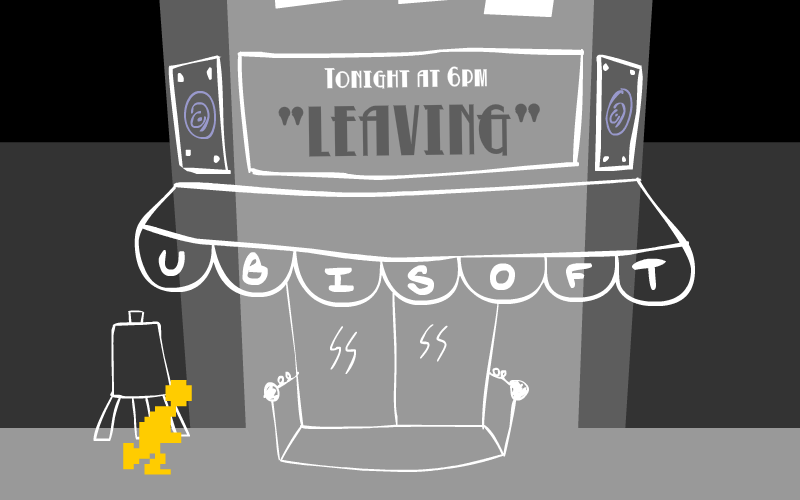Retro Replay Review
Gameplay
Leaving offers a delightfully simple yet emotionally resonant gameplay loop. You guide a bright yellow character along a single, unidirectional path using the arrow keys, with the ability to jump over small obstacles. This minimal control scheme removes complicated inputs and lets you focus on the journey itself, creating an accessible experience for players of all skill levels.
(HEY YOU!! We hope you enjoy! We try not to run ads. So basically, this is a very expensive hobby running this site. Please consider joining us for updates, forums, and more. Network w/ us to make some cash or friends while retro gaming, and you can win some free retro games for posting. Okay, carry on 👍)
Despite its straightforward mechanics, Leaving manages to evoke a surprising depth of feeling through environmental cues and character encounters. As you progress, you’ll meet a series of symbolic figures that represent the doubts, hopes, and reflections that the creator, William David, experienced in his final days at Ubisoft. These encounters break up the monotony of straightforward platforming and add layers of narrative context without overwhelming the player.
The pacing is intentionally measured, encouraging you to take in each platform and meeting as more than just a gameplay hurdle. You’ll find that the act of jumping over a small gap suddenly feels significant when it’s framed as a metaphor for taking risks or overcoming personal fears. The simplicity of controls helps maintain emotional focus, letting you absorb the story rather than wrestle with complex button combos.
Graphics
Visually, Leaving adopts a minimalist aesthetic that reinforces its contemplative tone. The protagonist’s vibrant yellow silhouette stands out sharply against the muted, often monochromatic backgrounds, ensuring clarity of movement and immediate recognition on every screen. This stylistic choice also mirrors the idea of an individual standing out against the corporate backdrop he’s about to leave behind.
The environments are crafted with subtle gradients and simple geometry, evoking a sense of calm and introspection. Each stage feels like a hallway or corridor you’re traversing, emphasizing the linear nature of the story but also invoking the metaphor of a hallway leading toward new horizons. Occasional environmental details—flickering lights, shadowy doorways, floating particles—add depth without distracting from the core journey.
Character designs are equally restrained yet expressive. The supporting figures you meet are rendered as abstract shapes or silhouettes, their limited animation conveying a range of emotions—hesitation, encouragement, nostalgia—through subtle motions or changes in color. This abstraction invites players to project their own feelings onto these figures, making the visual experience personal and resonant.
Story
At its heart, Leaving is an autobiographical allegory of William David’s decision to depart from Ubisoft and forge his own path as an independent developer. Though concise, the narrative unfolds beautifully through visual metaphors and brief, poignant interactions rather than lengthy dialogue or cutscenes. This lends a poetic quality to the story, encouraging players to reflect on their own life decisions as they guide the protagonist forward.
Each character you encounter embodies a facet of the creator’s emotional journey: excitement for the future, anxiety about the unknown, fond memories of past collaborations. These meetings are never overtly didactic; instead, they pop up at key moments to remind you why leaving can be both exhilarating and frightening. The story’s brevity ensures there’s no filler—every screen has narrative purpose.
The final segment ties the gameplay and symbolism together in a touching crescendo. Without giving away spoilers, you’ll feel a genuine sense of release as the yellow figure steps into open space, mirroring that moment when a developer publishes their first solo project. It’s a satisfying emotional payoff that resonates long after the credits roll.
Overall Experience
Leaving is a perfect example of how indie games can deliver a powerful emotional punch without blockbuster budgets or sprawling open worlds. Its minimal controls, concise length, and focused storytelling make it a remarkable bite-sized journey that can be completed in under 20 minutes, yet leave you thinking for hours afterward. For players who appreciate narrative-driven experiences, it’s a must-play.
The game’s short runtime may feel light to those seeking hours of platforming challenges, but its intention is clear: to offer a moment of introspection rather than a marathon session. This makes Leaving an excellent choice for players looking for a meaningful interlude between larger titles or a heartfelt gift for friends embarking on their own career changes.
Overall, Leaving stands out as both a creative farewell from a seasoned developer and a warm welcome to his future as an independent creator. With its harmonious blend of simple gameplay, evocative visuals, and touching narrative, it’s a brief but unforgettable experience. Whether you’re a fan of artful platformers or drawn to stories of personal transformation, Leaving is well worth your time.
 Retro Replay Retro Replay gaming reviews, news, emulation, geek stuff and more!
Retro Replay Retro Replay gaming reviews, news, emulation, geek stuff and more!








Reviews
There are no reviews yet.